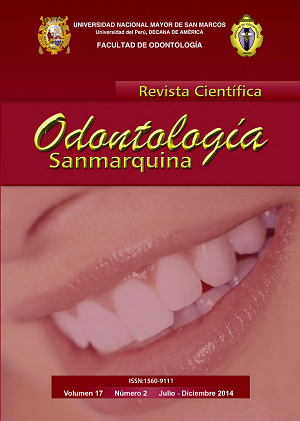Comparison of sealing quality of three root canal filling techniques through stereoscopic microscope
DOI:
https://doi.org/10.15381/os.v17i2.11028Keywords:
Sealing quality, Root canal filling techniques, Beefill, Tagger, Lateral condensation.Abstract
Objective: This study is an in vitro evaluation of three-dimensional root canal sealing ability of three obturation techniques: Lateral condensation, Tagger’s hybrid technique and thermoplastic Beefill 2 in 1 in mandible teeth. Methodology: it was used 30 first lower premolars which were randomly divided into three groups of 10 each. Root canals were cleaned, disinfected and shaping. The groups of Lateral condensation technique and Beefill 2 in 1 were prepared with Mtwo System, and Tagger’s hybrid technique with the University of Oregon Crown Down technique. Samples were prepared and cross sections were performed in the third cervical (3 mm), medium (6 mm) and apical (9mm), and then taken to the stereoscopic microscope. Results: Statistical analysis was performed with Chi square and comparison of proportions with the Z tests on 5% level of significance. Group 3 (lateral condensation), Group 2 (hybrid of Tagger), Group 1 (Beefill 2 in 1). In cervical third there were no statistically significant differences between the three systems, (X2=3.36), (p=0.186), it was evidenced the presence of gaps only in groups 2 and 3. At the middle third (X2=6.67) there was statistically significant difference of the seal quality of Beefill respect the others, (p=0.036). At the apical third (X2=8.967) there was statistically significant difference of the seal quality of Beefill respect the others (p=0.014). The comparison of proportions with the Z test, confirmed the significance of the findings. Thermoplastic technique: Beefill 2 in 1, showed optimal quality seal in the three thirds showing statistically significant differences in middle and apical thirds (p<0.05). Conclusion: The thermoplastic continuous wave technique, Beefill 2 in 1 showed better sealing quality in the three thirds, since the heat-softened gutta percha and then being compacted, this runs around the entire root canal.Downloads
Downloads
Published
Issue
Section
License
Copyright (c) 2014 Marisa Jara-Castro, Mónica Llanoz- Carazas, Jesús Inga-Chuco

This work is licensed under a Creative Commons Attribution-NonCommercial-ShareAlike 4.0 International License.
AUTHORS RETAIN THEIR RIGHTS:
a. Authors retain their trade mark rights and patent, and also on any process or procedure described in the article.
b. Authors retain their right to share, copy, distribute, perform and publicly communicate their article (eg, to place their article in an institutional repository or publish it in a book), with an acknowledgment of its initial publication in the Odontología Sanmarquina.
c. Authors retain theirs right to make a subsequent publication of their work, to use the article or any part thereof (eg a compilation of his papers, lecture notes, thesis, or a book), always indicating the source of publication (the originator of the work, journal, volume, number and date).




















